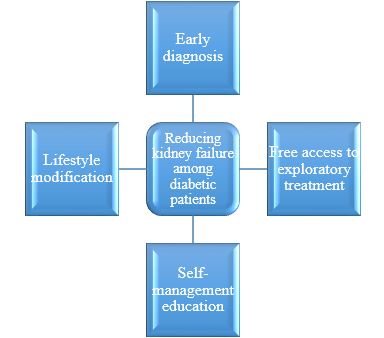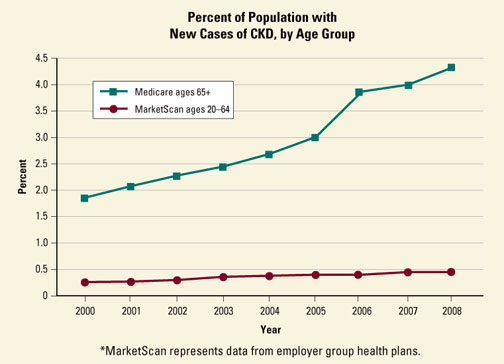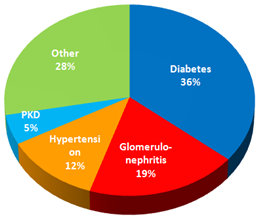Selection and Development of a Theoretical Framework
Chronic kidney disease has attracted the attention of many scholars who are interested in finding the ways of reducing the rate of deaths associated with it. According to Daugirdas (2011), chronic kidney disease is now affecting people across the ages because of the lifestyle of many Americans today, especially those who are diabetic. It is important to find ways of reducing kidney failure among the diabetic patients. According to the research by Lewis (2011), the following framework can be used in managing the chronic kidney disease based on a healthy lifestyle.

This theoretical framework identifies four main areas that can help in eliminating the possibilities of diabetic patients developing a kidney failure.
Literature and Data Explaining the Phenomena
Researchers have gathered massive information about chronic kidney disease and its relationship with diabetes. According to Himmelfarb and Sayegh (2010), it can be fatal if a patient suffering from diabetes develops kidney failure. According to the data collected from Center for Disease Control and Intervention by Daugirdas (2011), there has been a constant rise in the new cases of chronic kidney disease in the United States as shown in the graph below.

According to the statistics presented in the table above, there has been a consistent rise in new cases of chronic kidney disease in this country. This defeats the spirit of Healthy People 2020 principles that were set to help reduce the mortality rates from various diseases. People aged over 65 years are at a greater risk of acquiring this disease than the younger generations. According to Lewis (2011), chronic kidney disease is more prevalent among people suffering from diabetes. This is shown in the figure below.

According to the research by Lewis (2011), it shows that people suffering from diabetes are at a greater risk of having chronic kidney disease. These patients are at greater risks of developing kidney failure, especially if the condition is not managed properly. The condition may be worse if the affected patient is an elderly person. The United States’ government spends a lot in health trying to battle chronic kidney disease, which has become very common in this country (Daugirdas, 2011). Although positive strides have been made through public-private partnership, a lot more remains to be done in order to win this battle.
Potential Interventions for the Problem
Based on the framework developed above, the stakeholders should focus on four main factors in order to win this war. The first factor is early detection of the disease. Chronic kidney disease can be treated easily when it is detected early enough. Those suffering from diabetes should take regular check-ups to help detect this disease at an early stage. The government, in conjunction with other non-governmental organizations, should ensure that there is free exploratory treatment among those suffering from diabetes. This will help lift the limitation of the cost of medication.
According to Himmelfarb and Sayegh (2010), education is a strong tool that can help in the fight against chronic kidney disease among people suffering from diabetes. Government and private institutions should facilitate education about this disease among the target group. It is also important to modify one’s lifestyle in terms of nutrition and physical exercise in order to stay healthy.
References
Daugirdas, J. T. (2011). Handbook of chronic kidney disease management. Philadelphia: Lippincott Williams & Wilkins Health.
Himmelfarb, J., & Sayegh, M. H. (2010). Chronic kidney disease, dialysis, and transplantation: Companion to Brenner & Rector’s the kidney. Philadelphia: Saunders.
Lewis, R. (2011). Understanding Chronic Kidney Disease: A guide for the non-specialist. Keswick: M & K Update Ltd.
